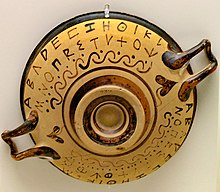
Back Ψ Abkhazian Psi (letter) Afrikaans Ψ ALS بسي (حرف) Arabic Ψ ARC Psi (Buachstob) BAR Псі (літара) Byelorussian Псі (грэцкая літара) BE-X-OLD Пси Bulgarian সাই Bengali/Bangla
This article needs additional citations for verification. (May 2013) |
 | ||||||||||||||||||||||||||||||||||||||||||||||||
| Greek alphabet | ||||||||||||||||||||||||||||||||||||||||||||||||
|---|---|---|---|---|---|---|---|---|---|---|---|---|---|---|---|---|---|---|---|---|---|---|---|---|---|---|---|---|---|---|---|---|---|---|---|---|---|---|---|---|---|---|---|---|---|---|---|---|
|
||||||||||||||||||||||||||||||||||||||||||||||||
| History | ||||||||||||||||||||||||||||||||||||||||||||||||
|
||||||||||||||||||||||||||||||||||||||||||||||||
| Diacritics and other symbols | ||||||||||||||||||||||||||||||||||||||||||||||||
| Related topics | ||||||||||||||||||||||||||||||||||||||||||||||||

Psi /ˈ(p)saɪ, ˈ(p)siː/ (P)SY, (P)SEE[1] (uppercase Ψ, lowercase ψ or 𝛙; Greek: ψι psi [ˈpsi]) is the twenty-third and penultimate letter of the Greek alphabet and is associated with a numeric value of 700. In both Classical and Modern Greek, the letter indicates the combination /ps/ (as in English word "lapse").
For Greek loanwords in Latin and modern languages with Latin alphabets, psi is usually transliterated as "ps".
The letter's origin is uncertain. It may or may not derive from the Phoenician alphabet. It appears in the 7th century BC, expressing /ps/ in the Eastern alphabets, but /kʰ/ in the Western alphabets (the sound expressed by Χ in the Eastern alphabets). In writing, the early letter appears in an angular shape (![]() ).
There were early graphical variants that omitted the stem ("chickenfoot-shaped psi" as:
).
There were early graphical variants that omitted the stem ("chickenfoot-shaped psi" as: ![]() or
or ![]() ).[citation needed]
).[citation needed]
The Western letter (expressing /kʰ/, later /x/) was adopted into the Old Italic alphabets, and its shape is also continued into the Algiz rune <ᛉ> of the Elder Futhark.
Psi, or its Arcadian variant ![]() or
or ![]() was adopted in the Latin alphabet in the form of "Antisigma" (Ↄ, ↃC, or 𐌟) during the reign of Emperor Claudius as one of the three Claudian letters.[2] However, it was abandoned after his death.[citation needed]
was adopted in the Latin alphabet in the form of "Antisigma" (Ↄ, ↃC, or 𐌟) during the reign of Emperor Claudius as one of the three Claudian letters.[2] However, it was abandoned after his death.[citation needed]
The classical Greek letter was adopted into the early Cyrillic alphabet as "Ѱ".
- ^ "psi". The Chambers Dictionary (9th ed.). Chambers. 2003. ISBN 0-550-10105-5.
- ^ Oliver, Revilo P. (1949). "The Claudian Letter Ⱶ". American Journal of Archaeology. 53 (3): 249–257. doi:10.2307/500662. JSTOR 500662. S2CID 193082268.